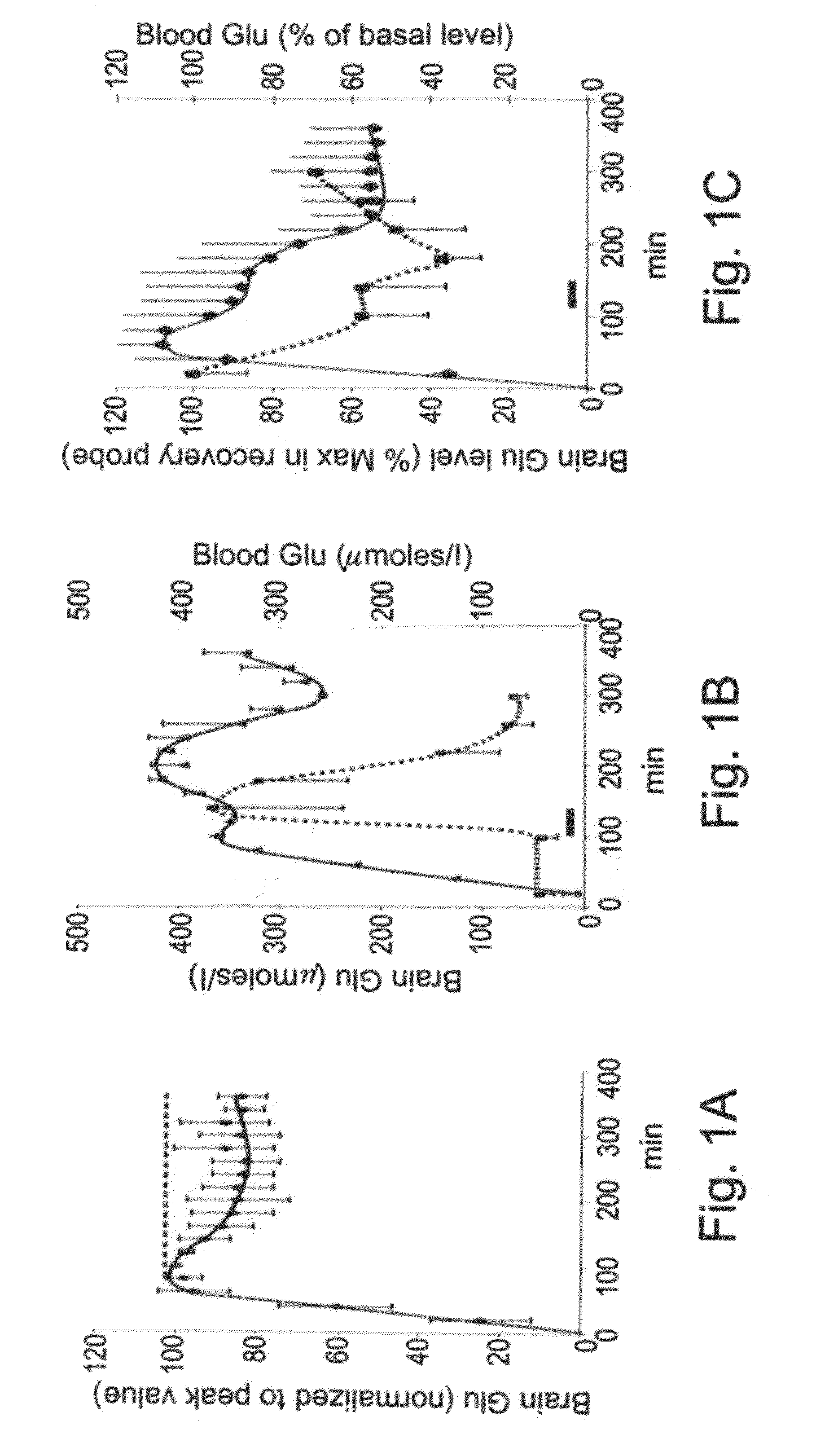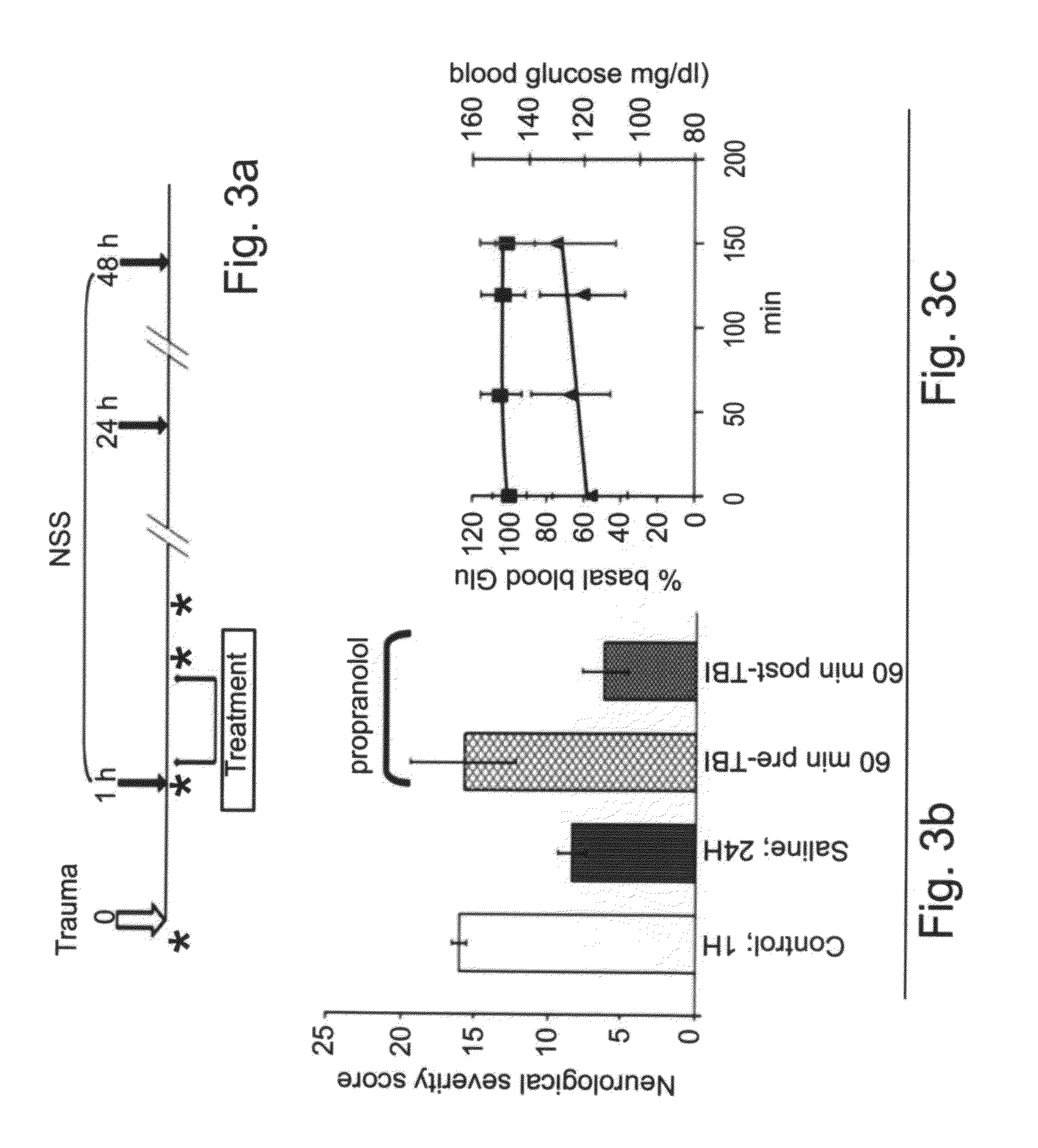Method And Composition For Proctecting Neuronal Tissue From Damage Induced By Elevated Glutamate Levels
a technology of glutamate and neuronal tissue, which is applied in the direction of drug compositions, biocides, peptide/protein ingredients, etc., can solve the problems of neuronal death, excessive stimulation, and accelerated depletion of these limited energy resources, so as to reduce blood glutamate levels, and reduce extracellular brain glutamate levels
- Summary
- Abstract
- Description
- Claims
- Application Information
AI Technical Summary
Benefits of technology
Problems solved by technology
Method used
Image
Examples
example 1
Brain Excess Glu Levels are Regulated by a Brain-to-Blood Glu Efflux
[0186]Glu efflux from the brain parenchyma interstitial fluid (ISF) to blood was first assessed [10]. The dual-probe brain microdialysis was used and perfused through the delivery probe inserted in the striatum of anesthetized rats a Glu solution while simultaneously perfusing artificial CSF through a recovery probe, located at 1 mm distance. Studies of dual-probe microdialysis describe a tissue delivery of solutes from the delivery probe of 3-6% [12] and a solute recovery of 5% in the recovery probe [13]. As Glu flows out of the first probe, it diffuses through the brain parenchyma where it is taken up into glial cells, neurons and blood capillary endothelial cells. However, as Glu keeps oozing from the delivery probe and saturates the transporters, it eventually reaches the recovery probe if its starting concentration is sufficiently high (>0.5M).
[0187]FIG. 1A shows that linearly increasing amounts of Glu arrive w...
example 2
Regulation of Blood Glu Levels by Stress
[0193]What causes the spontaneous decrease of blood Glu levels? It was suggested that such decrease could be part of a general stress response activating the hypothalamo-pituitary-adrenal (HPA) axis and the sympathetic nervous system (SNS) [15]. Since the stress response involves the release into blood of stress hormones such as cortisol, noradrenaline and adrenaline, their respective effects on the blood levels of glutamate and glucose were tested, the latter serving as a stress marker [16, 17].
[0194]FIG. 2A illustrates the fact that while neither cortisol nor noradrenaline affected blood Glu levels, adrenaline, administered over 30 min, caused a sustained blood Glu decrease to about 60% of its basal levels. As excess brain Glu could cause the activation of a stress response [15], we tested the effects of the mere insertion into brain parenchyma of a microdialysis probe. FIG. 2B shows that the probe insertion is a stressful procedure as it ca...
example 3
Stress Causes a Spontaneous Recovery from Traumatic Brain Injury
[0195]The decrease of blood Glu levels caused by stress was then addressed for its ability to neuroprotect from a brain insult well known to produce excess Glu levels in the brain of rodents [18-20] and of human victims of head injury [19, 21-23].
[0196]To this end, rats were subjected to a traumatic brain injury (TBI) [24], assessed a neurological severity score (NSS) 1, 24 and 48 h post injury, and monitored in parallel the blood Glu levels as described in FIG. 3A. The inflicted brain injury was very severe as expressed by the large NSS value of 16.2+ / −0.5 (n=33) measured at 1 h post TBI (FIG. 3C-left first column). Animals appear nevertheless to rapidly recover since, in comparison to the NSS measured at 1 h post TBI, there was a very significant NSS improvement after 24 h (FIG. 3C-first two columns). As such spontaneous improvement could possibly be attributed to the stress / adrenaline-induced decrease of blood Glu le...
PUM
| Property | Measurement | Unit |
|---|---|---|
| stress hormone activity | aaaaa | aaaaa |
| concentration | aaaaa | aaaaa |
| concentrations | aaaaa | aaaaa |
Abstract
Description
Claims
Application Information
 Login to View More
Login to View More - R&D
- Intellectual Property
- Life Sciences
- Materials
- Tech Scout
- Unparalleled Data Quality
- Higher Quality Content
- 60% Fewer Hallucinations
Browse by: Latest US Patents, China's latest patents, Technical Efficacy Thesaurus, Application Domain, Technology Topic, Popular Technical Reports.
© 2025 PatSnap. All rights reserved.Legal|Privacy policy|Modern Slavery Act Transparency Statement|Sitemap|About US| Contact US: help@patsnap.com



